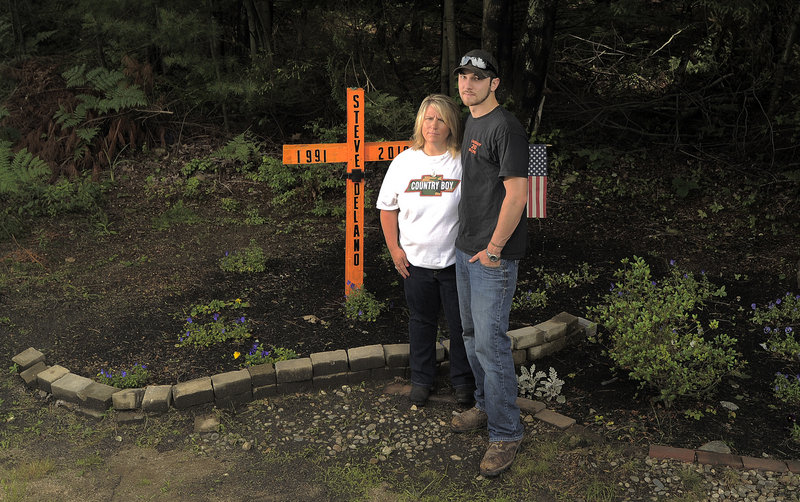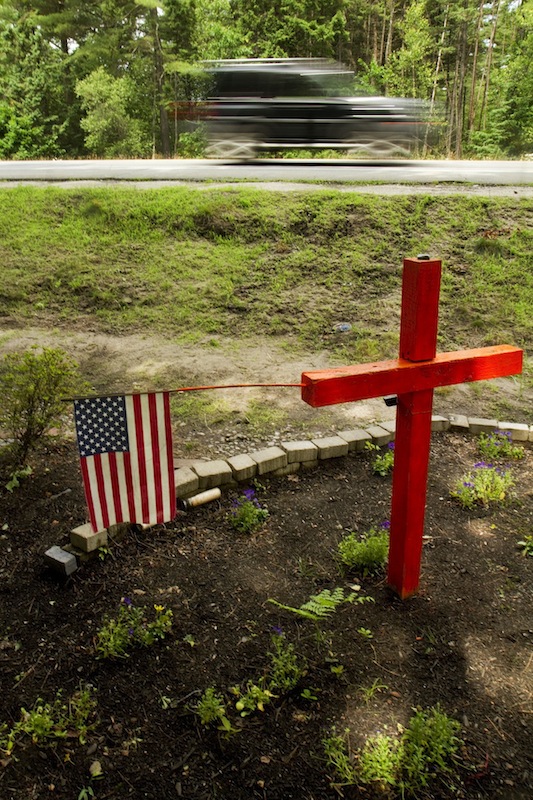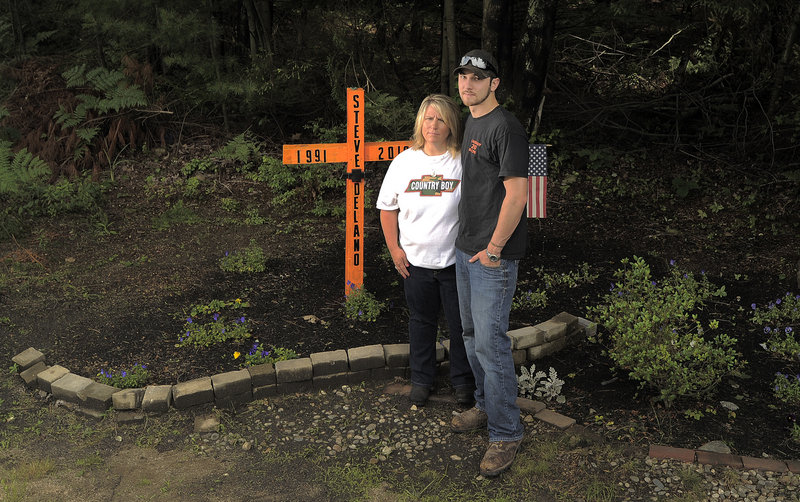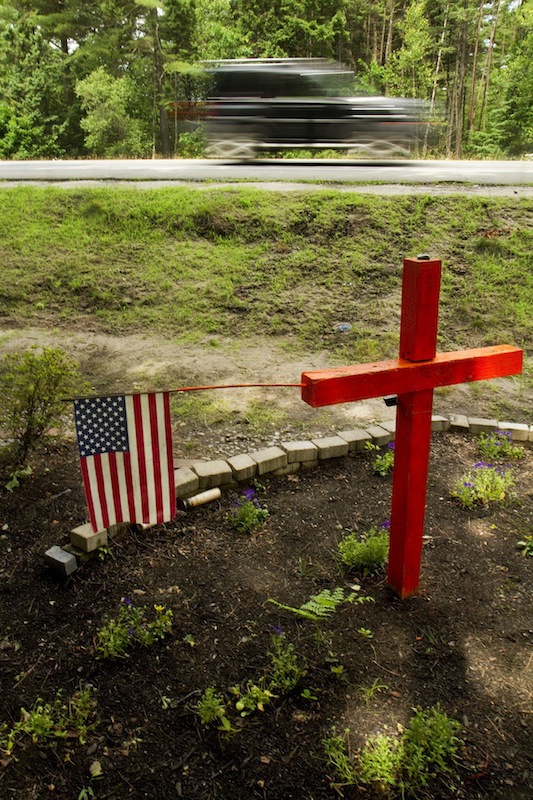SCARBOROUGH – Town officials plan to propose an ordinance to regulate roadside memorials at sites of fatal crashes, joining communities nationwide that have tried to address the issue, often with limited success.
Several sites in Scarborough have memorials where people died in crashes. That has prompted some town councilors to call for a policy in which the town would work with families of the victims and owners of the properties to be respectful of victims’ memories and cognizant of road safety.
The proposal was prompted largely by a memorial at the intersection of Payne and Holmes roads, where Steven Delano, a Scarborough High School senior, was killed on May 8, 2010, when the car he was driving was hit by a tanker truck. Delano, 18, was driving three friends to the high school prom at the time of the crash.
Town Manager Thomas Hall said officials considered all of the roadside memorials in town before drafting the proposed ordinance. The memorial for Delano stood out because of its size and because people have continued to visit it frequently since 2010.
“In that one in particular, there was such grief that it served as a gathering spot,” Hall said. “It was truly a public safety issue.”
He said the memorial is now smaller, but for a while it included a decorated Christmas tree and other items that distracted drivers along Payne Road.
“The intention is not to disallow these. It is to provide some level of consistency. We think this is a better way to memorialize someone,” Hall said. “If people want to mark where the spot is, this policy provides a way for them to do that. We think it would be better to have a policy in place instead of playing it by ear.”
Communities that try to legislate how people grieve with roadside memorials and spontaneous shrines are usually on a “fool’s errand,” said Sylvia Grider, professor emerita of anthropology at Texas A&M University, who has studied the phenomena of roadside memorials for more than 20 years.
“All over the country, this same problem is cropping up and each community has to deal with it,” she said. “This is a very deep-rooted tradition in American culture that is becoming more prevalent because of the media attention. In communities that have passed legislation, people go ahead and put them up anyway.”
While the Scarborough Town Council plans to consider a new policy on July 17, a young man who maintains the memorial for Steven Delano says he has rallied hundreds of people to oppose it.
Kevin Grondin, who was in the crash with Delano, his best friend, and was in a coma for weeks afterward, said the memorial should remain untouched.
“They will never touch it, ever,” said Grondin, who visits three or four times per week.
None of the communities surrounding Scarborough has rules for roadside memorials. And unlike many other states, Maine has no policy for memorials. A recent effort at the state level to protect and regulate the emotionally charged shrines was soundly defeated.
State Rep. Kathleen Chase, a Republican from Wells, proposed legislation this year to make it a crime to tamper with a private memorial in a public right of way, punishable by as much as a year in jail and a fine of $2,000. Chase’s bill also included a size limit for memorials and limited the time they could be protected to one year.
The bill was defeated in the Legislature in March, with the House voting against it by a nearly 2-to-1 ratio.
Chase said she pushed for the legislation on behalf of a family who put up a cross on Tatnic Road in Wells in memory of their son and another teenager, who were killed there in 2010.
“Someone stole the cross. There was a horrible accident in which two young teenagers got killed. They put up a cross, and someone took it,” Chase said. “Obviously, the family was very upset by that. I put the bill in at their request.”
Before Scarborough’s proposed policy was drafted, Police Chief Robert Moulton said he looked to other towns for models but couldn’t find any in Maine. Instead, he sought the input of three families who lost loved ones in crashes.
Moulton said town councilors asked him to look into the issue after they heard complaints that the roadside memorials were unsightly and distracting to motorists.
Other states ban roadside memorials or have rules that allow state workers to remove them after a specific length of time.
Vermont prohibits roadside memorials on state roads, considering them “a danger to all highway users,” said Scott Rogers, director of operations for the Vermont Agency of Transportation. The state adopted a policy in February 2010 to remove memorials.
“Family members and friends who install and maintain roadside memorials are often distraught, mourning their loss, and focused on finding a little glimpse of relief, which means they are lacking full awareness of their surroundings,” Rogers said in an email. “This not only puts them in danger, but also places other highway users at risk, especially during storm events and night hours.”
In New Hampshire, roadside memorials are allowed on state roads but are removed by the Department of Transportation after six months, said spokesman Bill Boynton. The law has been in place for at least a decade.
“While it’s an emotional issue, we certainly want to be sensitive to the family’s feelings,” Boynton said. “From my perspective, it seems to be a compromise that the public has accepted.”
Massachusetts has no policy for roadside memorials.
“We exercise our best judgment with roadside memorials. We understand they are an expression of grief, but we must also be focused on safety,” said MassDOT spokeswoman Sara Lavoie. “Mementos that are placed at the scene of fatal incidents are removed in time. Rarely are requests made for permanent memorials to be placed at the roadside and rarely would they be allowed.”
The debate in Scarborough over whether to regulate roadside memorials like the cross and flowers where her son was killed has left Cindy Delano with a “lot of mixed emotions.”
“Unless someone’s gone through this, they don’t know what you feel,” she said.
Her son’s death caused “overwhelming” grief among young people in town and surrounding communities, she said.
“This was a high school kid. For a lot of these people, it was the first death they experienced,” Delano said.
The site now includes the orange cross planted in a small flower garden, edged by a ring of paver bricks. Grondin repainted the cross in the spring with orange paint and black lettering, she said.
“I don’t think it’s a big distraction at this point,” Delano said. “I know some people don’t think it’s necessary and that we should be grieving at a cemetery.”
She said several of her son’s friends set up the memorial immediately after his death and continued to add to it, making it much larger than it is now.
“Was it overwhelming? Yes, it was, but so were the emotions all these kids were going through,” she said. “We didn’t set it up. It was set up by all these kids.”
Scott Dolan can be contacted at 791-6304 or at:
sdolan@pressherald.com
Send questions/comments to the editors.






Success. Please wait for the page to reload. If the page does not reload within 5 seconds, please refresh the page.
Enter your email and password to access comments.
Hi, to comment on stories you must . This profile is in addition to your subscription and website login.
Already have a commenting profile? .
Invalid username/password.
Please check your email to confirm and complete your registration.
Only subscribers are eligible to post comments. Please subscribe or login first for digital access. Here’s why.
Use the form below to reset your password. When you've submitted your account email, we will send an email with a reset code.